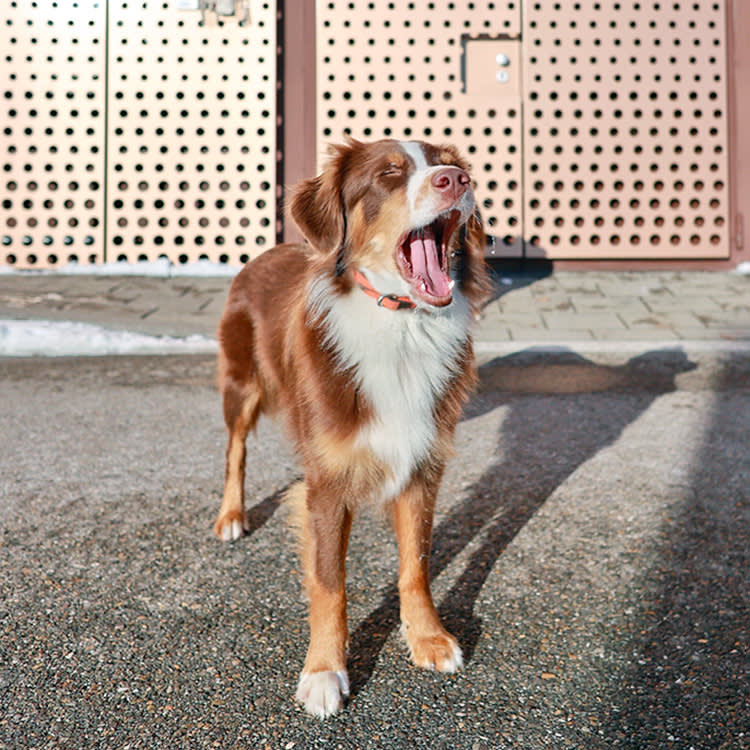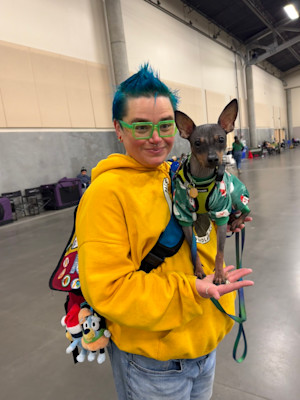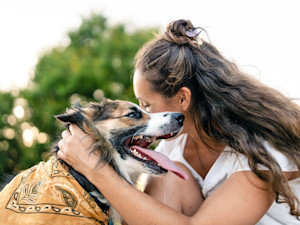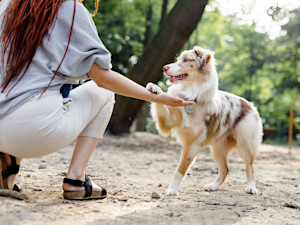10 Surprising Ways You Can Decode Your Dog’s Body Language
All their little movements mean a lot.

Share Article
Ever wish you could talk to your dog? Maybe you want to share your deepest, darkest thoughts and confessions like they’re your perfect little therapist. Turns out you can!
Learning about canine body language is a great way to learn about how your dog is feeling, and what emotions they are experiencing. Body language is a primary way our dogs communicate their feelings so learning to decode your dog’s body language can improve communication between the two of you.
Understanding canine body language is also useful for decoding the way your dog is feeling while out on walks and meeting new people and dogs. Here are 10 surprising ways your dog’s body is communicating how they are feeling.
Yawning
Dogs yawn when they are tired, but it can also have more significant meanings. Yawning is what is known as a calming signal, and many dogs will yawn when they are in stressful situations. It allows dogs to self-soothe and calm themselves down after being upset or stressed. Yawning is also a way that dogs can communicate to others that they are feeling overwhelmed or uncomfortable.

If you notice your dog yawning, and it’s not a time when they are usually tired, this is an indication that they would benefit from their stress being reduced. The easiest way to do this is to create distance between your dog and whatever stimulus is causing stress. For example, if you’re out walking, you may need to walk in the direction away from other dogs or people. Or if your dog is overwhelmed by guests in the home, give your dog a quiet place away from visitors to relax.
Tail-wagging
A wagging tail doesn’t just mean that a dog is happy. The wag of a dog’s tail can tell you a lot about how they are feeling, everything from heightened arousal to joy. Large waves of the tail is generally a good sign that your dog is happy. A fast-moving, tightly twitching tail might mean that your dog is excited but could also mean that your dog is frustrated and becoming stressed.
A stiff tail signifies that your dog is alert and focusing, and can be a sign that your dog is feeling agitated. To further decode you would want to look at the rest of your dog’s body language and the situation. The higher a dog’s tail is,, the more alert and confident the dog is feeling. On the other hand, a tucked tail often indicates that a dog is feeling less confident. Dogs that have long tails are easier to read than dogs with curled or stub tails, though all dogs use their tails to communicate.
Lip-licking
A dog who is licking their lips is often indicating that they are feeling stressed, anxious, or nervous and signaling to other dogs and people that they are not a threat. Lip-licking is also an appeasement behavior, meaning that a dog may lick their lips in an effort to reduce or eliminate perceived conflict in a stressful situation.
Lip-licking communicates that your dog is feeling uncomfortable and is a way they can try to self-soothe during times of stress. If you notice that your dog is communicating that they are stressed, this is the perfect opportunity for you as the guardian to step in.
Try to find ways to reduce your dog’s stress, like creating distance from something that is causing your dog to be concerned. You can also provide your dog with stress-reducing, soothing activities like a snuffle mat, lick mat, or a long-lasting, dog-safe chew.
Eyes
A dog’s eyes can tell you a lot about how they are feeling. A dog who is staring hard and unblinking is communicating they are agitated and uncomfortable, which can lead to them behaving aggressively.
A dog with soft and relaxed eyes is feeling happy and relaxed. Dogs whose eyes are big, and wide with the whites showing (with the exception of those who have naturally droopy eyes where the white is always visible) are displaying what is often called “whale eye.” This is a clear indication that a dog is likely feeling stressed or afraid.
Ear positioning
While it’s easier to read a dog’s emotions when they have upright ears, all dogs use their ears to communicate. A dog whose ears are perked up and forward pressed shows that dog is alert and interested in what is going on.
If a dog’s ears are pressed or pinned back against their head, that is a sign that a dog is feeling worried or afraid. When a dog’s ears are relaxed in their neutral position depending on ear shape and size, the dog is calm and relaxed.
Panting
Panting is a way that dogs can cool themselves down during hot weather, but it’s also a way their bodies might be telling you something about how they are feeling. Dogs often pant when they are stressed or anxious. They may also pant when they are worked up and excited.
Hackles up
The fur on the back of a dog’s neck or back is formally known as piloerection. When dogs are having big feelings this hair may stand straight up. A dog might raise their hackles if they feeling aroused and agitated, dogs may also experience a piloerection at times unrelated to aggression. Dogs who are stressed or uncertain may raise their hackles.
This natural bodily reaction is involuntary and not something your dog has control over. I like to think of piloerection as an early warning sign that your dog is starting to have big feelings. If you notice those hackles rising, this is the perfect opportunity to redirect them using treats, toys, praise, and play. By getting your dog’s attention back onto you, it’s possible to lower their arousal level and help them to refocus.
As your dog focuses on you, try to move them away from the cause of the stress. By regaining your dog’s focus, you can help them to regulate their emotions and be less bothered by what was causing them to be stressed or concerned.
Posture
Posture can tell you a lot about how a dog is feeling. A dog with a stiff body and ears pressed forward is likely alert and possibly becoming concerned.
Similarly, when a dog’s body is stiff, with weight shifted forward and their head up, they may be feeling agitated or threatened. A dog’s body lowered and stiff, with ears tucked, is communicating that they are feeling worried. Meanwhile, a dog whose body is soft, wiggly, and relaxed from head to tail is feeling happy and relaxed.
Shake it off
Dogs don’t just shake to get dry after swimming or going for a walk in the rain. Shaking another calming signal for dogs and a way that they can literally shake off big feelings. Many dogs will shake after experiencing a stressful situation as a way to remove that tension from their body and communicate that they are getting back to a normal and relaxed state.
This body communication is especially common when dogs are playing together. Dogs may stop mid-game and shake to communicate that they are having a good time and to break the tension if the game has gotten a little bit rough.
Mouth shape
In addition to yawning and panting, the shape of a dog’s mouth can tell us a lot about how they are feeling. A dog whose mouth is relaxed and slightly open or softly closed is likely feeling safe, calm, and relaxed. When a dog appears to be “smiling” with lips raised to show teeth with squinting eyes, chances are the dog is uncomfortable. This face is sometimes called a “submissive grin.”
A more exaggerated version of this facial expression, when a dog has their lips pulled or curled back — facial features tight, with teeth exposed — is a dog who is communicating they are upset and giving a warning they may react aggressively.
Bottom line: Pay attention
Knowing what to look for in your dog’s body is incredibly important. They, like you, have their own feelings and thoughts. They love you, and they want to hang out with you. But there may be sometimes they need some space or need you to help them get out of a situation they definitely do not want to be in. The best way you can return the love is to listen to them — in all the ways they appreciate.

Sassafras Patterdale
Sassafrass Pattrdale is a certified professional dog trainer — knowledge assessed (CPDT-KA) and an award-winning author and freelance writer. Sassafras’s work has been honored by organizations ranging from the American Library Association, and the Lambda Literary Foundation, to the Dog Writers Association of America and the Cat Writers Association. Sassafras is the author of 12 fiction and nonfiction books. The film rights to Sassafras’s Lambda Literary Finalists novel, Lost Boi, were recently acquired. Their training books are Tricks In The City and Chew This Journal.
Related articles
Why Is Your Dog Side-Eyeing You? Learn What This Means
It’s kind of goofy, but there may actually be a reason they’re doing it.
![Corgi dog sitting and looking away at home.]()
Become a Dog Whisperer by Understanding What Dog-Ear Positions Mean
Welcome to next-level pet parenting.
Why Does Your Dog Squint at You? Learn What This Means About Them
Are they trying to tell you something, or what?
Why Does My Dog Stretch So Much?
Sometimes, it’s more than just some tight muscles.
![Woman hugging her dog outside.]()
8 Signs That Show Your Dog Is Happy
Beyond a wagging tail.
![Woman training her dog outside.]()
7 Lies We’ve Been Told About What Dogs Like
And what they need.







